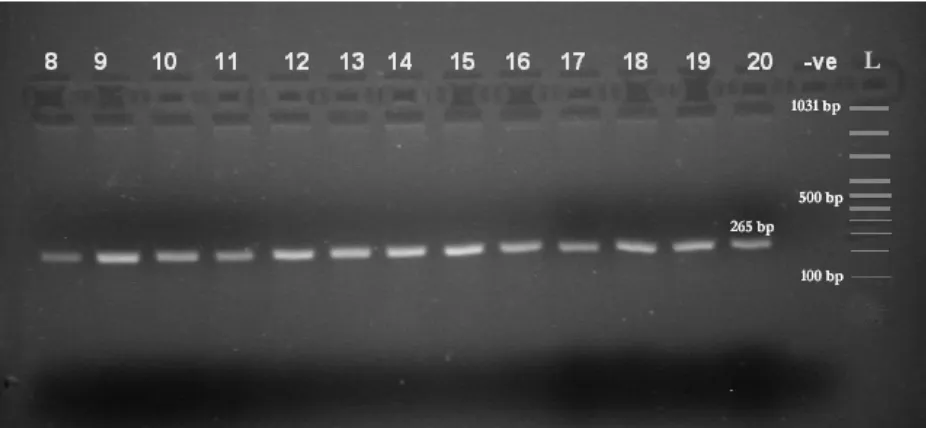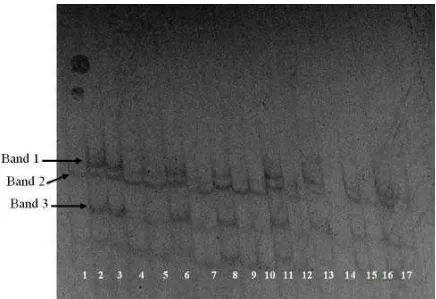GENETIC POLYMORPHISM STUDY OF IGF-I GENE
IN BUFFALOES OF GUJARAT
Shadma Fatima, S.M. Bhatt, C.D. Bhong, D.N. Rank and C.G. Joshi
Department of Animal Biotechnology, College of Veterinary Science and Animal Husbandry, Anand Agricultural University, Anand, Gujarat - 388 001, India
ABSTRACT
The IGF plays an important role in lactation. Polymorphs of IGF gene are reported to be significantly associated with milk production and constituent traits. This study was undertaken to detect polymorphism at the genetic level and to explore allelic variability at this locus. A total of 150 animals, belonging to three breeds of riverine buffalo, viz. Mehsani, Surti and Jaffarabadi, were scanned. A 265 bp segment of gene was amplified by polymerase chain reaction and subsequently, subjected to single strand conformation polymorphism (SSCP) to identify different allelic patterns. All the three breeds exhibited three different SSCP patterns, but the sequence analysis could not confirm polymorphism. However, the sequence showed variation at three positions (at 89C/T, 98G/ T and 167T/C) when compared with reference sequence. The study will augment the information and will be useful in further studies to determine the role of IGF in the regulation of milk synthesis and improvement of quality and quantity of milk in riverine buffaloes.
Keywords: IGF-I gene, buffalo, SSCP, sequencing
INTRODUCTION
India is the world leader in milk production, producing 86.96 MMT per year. The country has a buffalo population of 96.9 million which is about 56% of the world buffalo population and contributes more than 50% of total milk production of the country. Some of the best-known breeds are Murrah, Nili-Ravi, Jaffarabadi, Surti, Mehsani and Nagpuri. In
the dairy sector, the buffalo could emerge as a promising alternative to crossbred cattle due to its adaptability to varied ecological conditions, higher milk yield and higher fat content, realizing a premium price. Hence, analyzing candidate genes and identifying polymorphism associated with high milk production can be a tool for improving milk production in buffaloes.
namely, when applied to candidate genes associated with quantitative genetic variation in traits of economic importance. The objective of this study was to search for the IGF polymorphism in buffaloes, using SSCP analysis.
MATERIALS AND METHODS
Genomic DNA was extracted from blood samples collected from 50 animals each of the Surti, Mehsani and Jaffarabadi breeds.
PCR amplification: The IGF1 gene was amplified by PCR using the primer pairs (Ge et al., 1997) shown in Table 1. PCR reactions consisted of 25 to 50 ng of genomic DNA; 1X Mastermix (MBI Fermentas), 10 picomoles of each primer in a final volume of 25 μl. Cycling conditions were denaturation at 95oC for 30 seconds, annealing at 55oC for 30 seconds and extension for 30 seconds at 72oC for 30 cycles. The product of each amplification was analyzed by agarose gel electrophoresis. The amplified PCR products were subjected to SSCP analysis.
SSCP analysis: For SSCP analysis, to 5 μl of each amplification product was added 6x SSCP loading dye. The samples were heat-denatured at 95oC for 5 minutes, chilled at 0oC, and resolved on 6% polyacrylamide gels. Gels were run at 5 W (4oC cold room) constant power in 1 X Tris-borate EDTA. After electrophoresis, DNA was detected by silver staining and gels were transferred to Whatman 3 M paper and vacuum dried.
Sequence analysis: DNA fragments that displayed a modified electrophoretic pattern were selected for sequencing and were purified in low melting point agarose following the method described by Sambrook and Russel (2001). The concentration of the purified PCR product was determined and ligated using the InsT/AcloneTM PCR product cloning kit (MBI Fermentas) following the manufacturer’s instructions. Ligated plasmids were transformed in DH5α and recombinant clones were selected by blue white screening. Recombinant plasmids were extracted and purified as per the method described by Sambrook and Russel (2001). The purified recombinant plasmids were used as
templates for cycle sequencing. Cycle sequencing was performed using BigDye R Terminator v3.1 Cycle Sequencing Kit (Applied Biosystems, USA). Electrophoresis and data analysis was carried out on the ABI PRISM R 310 Genetic Analyzer using appropriate modules, basecallers, dyesets/primers and matrix files.
RESULTS AND DISCUSSION
A 265 bp fragment of IGF1 gene was amplified. PCR-SSCP of the amplified IGF fragments was performed to detect any mutation that might be present. Three types of SSCP band patterns were observed in the three buffalo breeds. The patterns were simple and consisted of only three bands. Pattern 1 consisted of band 2; pattern 2 of bands 1, 2 and 3 and pattern 3 of bands of bands 2 and 3 (Figure 2). The pattern frequency observed in the three breeds is given in Table 1. The samples showing differential band patterns were subjected to cloning and sequencing. The sequences obtained for segment of IGF1 in Mehsani, Surti and Jaffarabadi buffaloes have been submitted to the NCBI database (EU159114, EU159115 and EU159116). The sequence analysis of the IGF1 region in the three breeds of buffalo revealed no sequence variation. However, it revealed changes in nucleotide positions compared to reference sequence (Figure 3). It indicated that polymorphism revealed by SSCP could be independent of sequence variation.
Candidate genes have known biological functions related to the development or physiology of an important trait. Such genes can encode structural proteins or a member in a regulatory or biochemical pathway affecting the expression of the trait (Bryne and McMullen 1996) and can be tested as putative QTLs (Yao et al., 1996).
The study by Ge et al. (2001) characterizes a G > A transition polymorphism within an Eco130I site of intron 3 of the IGF1 gene in swamp buffaloes (Bubalus b. bubalis kerebau). Polymorphisms in the bovine IGF-I gene are associated with circulating IGF-I concentrations and growth traits. Additional polymorphisms in growth hormone axis genes that
O
O
are associated with production traits in ruminants have been reported by Grochowska et al. (2001). Similarly Lien et al. (2000) revealed three polymorphisms in noncoding regions of the IGF gene in the Norwegian cattle population. Li et al. (2006) studied allele frequencies of IGF1 which exhibited significant (P<0.05) deviation from neutral expectation and therefore, might be associated with divergence in North Eurasian cattle because of genetic selection.
Growth in animals is controlled by a complex system, in which the somatotropic axis plays a key
role. Genes that operate in the somatotropic axis are responsible for the postnatal growth, mainly GH that acts on the growth of bones and muscles mediated by IGF-1 (Sellier 2000). The IGF-1 gene is a candidate for growth in the bovine, since it plays a key role in growth regulation and development (Breier, 1999; Hossner et al., 1997; Tuggle and Trenkle, 1996).
If specific haplotypes can be defined at this candidate gene that can be associated with milk production, protein and fat content, it would be rendered available as a valuable genetic resource for improvement of these buffalo breeds.
Table 1. SSCP pattern frequency in the three breeds.
Figure 1. Amplified product of IGF-1 gene (265 bp) resolved on 2% Agarose Gel. Breeds/SSCP
Pattern I II III
Surti 46.0 43.0 11.0
Mehsani 4.5 60.0 35.5
Figure 2. SSCP patterns of IGF-1 gene in representative samples on 6 % PAGE. Pattern 1: Lane no. 1
Pattern 2: Lane no. 2, 3, 4, 5, 6, 7, 8, 9, 10, 11, 12, 13, 14, 15, 16 and 17
REFERENCES
Adam, C.L., T.S. Gadd, P.A. Findlay and D.C. Wathes. 2000. IGF-I stimulation of luteinizing hormone secretion, IGF-binding proteins (IGFBPs) and expression of mRNAs for IGFs, IGF receptors and IGFBPs in the ovine pituitary gland. J. Endocrinol., 166: 247-254. Breier, B.H. 1999. Regulation of protein and energy metabolism by the somatotropic axis. Domest. Anim. Endocrinol., 17: 209-218.
Brock, J.C. 1989. A Natural History of Domesticated Mammals. Cambridge, UK, Cambridge University Press (British Museum). 140-142.
Bryne, P.F. and M.D. McMullen. 1996. Defining genes for agricultural traits: QTL analysis and the candidate gene approach. Probe, 7: 24-27.
Dierkes, B., B. Kriegesmann, A. Silva, M. Schneider and B. Brenig. 1999. Characterisation of a G > A transition polymorphism within an Eco130I site of intron 3 of the insulin-like growth factor-1 (IGF1) gene of swamp buffaloes (Bubalus b. bubalis kerebau). Anim. Genet., 30: 405.
Fujita, M., M. Inoue, O. Tanizawa, S. Iwamoto and T. Enomoto. 1992. Alterations of the p53 gene in human primary cervical carcinoma with and without human papillomavirus infection. Cancer Res., 52: 5323-5328.
Ge, W., M.E. Davis and H.C. Hines. 1997. Two SSCP alleles identified in the 52 -flanking region of the bovine IGF1 gene. Anim. Genet., 28: 155-156.
Ge, Z., E. Miller, W. Nicholson, V. Hedgpeth and J. Gadsby. 2003. Insulin-like growth factor (IGF)-I and IGF binding proteins-2, -3, -4, -5 in porcine corpora lutea during the estrous cycle; evidence for inhibitory actions of IGFBP-3. Domest. Anim. Endocrinol., 25: 183-197.
Grochowska, R., P. Sorensen, L. Zwierzchowski, M. Snochowski and P. Lovendahl. 2001. Genetic variation in stimulated GH release and in IGF-I of young dairy cattle and their associations with the leucine/valine
polymorphism in the GH gene. J. Anim. Sci., 79: 470-476.
Kirkpatrick, B.W. 1992. Detection of a three-allele single strand conformation polymorphism (SSCP) in the fourth intron of the bovine growth hormone gene. Anim. Genet., 23: 179-180.
Lagziel, A., E. Lipkin and M. Soller. 1996. Association between SSCP haplotypes at the bovine growth hormone gene and milk protein percentage. Genetics, 142: 945-951. Li, M.H., T. Adamowicz, M. Switonski, I. Ammosov,
Z. Ivanova, T. Kiselyova, R. Popov and Kantanen. 2006. Analysis of population differentiation in North Eurasian cattle (Bos taurus) using single nucleotide polymorphisms in three genes associated with production traits. J. Anim. Genet., 37: 390-392.
Lien, S., A. Karlsen, G. Klemetsdal, D.I. Vage, I. Olsaker, H. Klungland, M. Aasland, B. Heringstad, J. Ruane and L. Gomez-Raya. 2000. A primary screen of the bovine genome for quantitative trait loci affecting twinning rate. Mamm. Genome, 11: 877-882.
Morohoshi, F., K. Hayashi and N. Munakata. 1991. Molecular analysis of Bacillus subtilis mutants deficient in the adaptive response to simple alkylating agents. J. Bacteriol., 173: 7834-7840.
Neibergs, H.L., A.B. Dietz and J.E. Womack. 1993. Single-strand conformation polymorphisms (SSCPs) detected in five bovine genes. Anim. Genet., 24: 81-84.
Orita, M., H. Iwahana, H. Kanazawa, K. Hayashi and T. Sekiya. 1989. Detection of polymorphisms of human DNA by gel electrophoresis as single-strand conformation polymorphisms. Proc. Nat. Acad. Sci. U.S. A., 86: 2766-2770.
Pravenec, M., L. Simonet, V. Kren, E. St Lezin, G. Levan, J. Szpirer, C. Szpirer and T. Kurtz. 1992. Assignment of rat linkage group V to chromosome 19 by single-strand conformation polymorphism analysis of somatic cell hybrids. Genomics, 12: 350-356.
Harbour Laboratory, Cold Spring Harbour, New York.
Sellier, P. 2000. Genetically caused retarded growth in animals. Domest. Anim. Endocrinol., 19: 105-119.
Shen, W., P. Wisniowski, L. Ahmed, D.W. Boyle, S.C. Denne and E.A. Liechty. 2003. Protein anabolic effects of insulin and IGF-I in the ovine fetus. American Journal of Physiology, Endocrinology and Metabolism, 284: 48-56.
Tuggle, C.K. and A. Trenkle 1996. Control of growth hormone synthesis. Domest. Anim. Endocrinol., 13: 1-33.
Werner, H.M., C.T. Adamo, Jr. Roberts and D. LeRoith. 1994. Molecular and cellular aspects of insulin-like growth factor action. Vitamins and Hormones, 48: 1-58.
Yao. J., S.E. Aggrey, D. Zadworny, J.F. Hayes and U. Kuhnlein. 1996. Sequence variations in the bovine growth hormone gene characterized by Single-Strand Conformation Polymorphism (SSCP) analyses and their association with milk production traits in Holstein. Genetics, 144: 1809-1816.
Son, D.S., N. Ikenoue, Y. Tagawa, M. Shimoda and E. Kokue. 2000. Non-linear pharmacokinetics of ofloxacin after a single intravenous bolus dose in pigs. J. Vet. Pharmacol. Ther., 23: 311-315.
Varoli, O. and M. Ferri. 1987. In vitro study of the antibacterial activity of ofloxacin against recent clinical isolates. Drug. Exp. Clin. Res., 13: 209-212.
Verho, M., V. Malerczyk, E. Dagrosa and A. Korn. 1985. Dose-linearity and other pharma-cokinetics of ofloxacin: a new, broad-spectrum
*Continued from page 158
antimicrobial agent. Pharmatherapeutica, 4: 376-382.
Wise, R. and M.R. Lockley. 1988. The pharmacokinetics of ofloxacin and a review of its tissue penetration. J. Antimicrob. Chemother., 38: 59-64.

